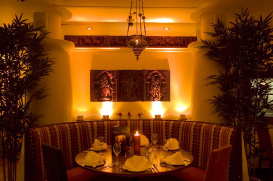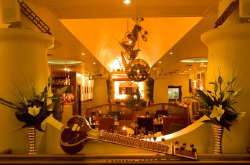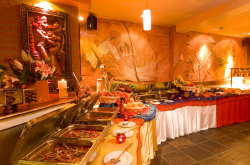Kama Sutra - a feast of the senses

331 Sauchiehall Street, Glasgow G2 3HU
Book a deal at Kama Sutra
A Festival of Flavours at Kama Sutra
Glasgow Restaurants: Indian
 Kama Sutra may just have the most extravagantly classy Asian restaurant interior in Scotland. The decor scheme caused a minor sensation when it first opened its doors on Sauchiehall Street more than a decade ago.
Kama Sutra may just have the most extravagantly classy Asian restaurant interior in Scotland. The decor scheme caused a minor sensation when it first opened its doors on Sauchiehall Street more than a decade ago.
Its contemporary design, with its huge tapering pillars and imposing bronze-faced door, was a world away from the straightforward and often stuffy appearance of more conventional culinary acts - and it made curry-watchers sit up and take notice.
The very look of the place hinted a similar pzazz might be expected in the cuisine - and, sure enough, the most insatiable culinary demands were suitably gratified: every taste, so to speak, was catered for.
As a flagship of the Harlequin empire, Kama Sutra was a bid to give lovers of Indian food a chic venue comparable to the style bars and clubs of the day, with the famous ancient love guide as its inevitable dominant theme.
Customers weren't, however, treated to anything as alarming as - for the sake of argument - a pop-up version of the Kama Sutra concealed in the menu. The allusions to the athletic gyrations denoted in the text were very low key: for example back-lit etched illustrations in, what else, red lampshades.
The menu headers had a sort of jauntily saucy tone to match - and if diners chose to believe that the whole dining experience might, as was arguably implied, have an aphrodisiac quality, then that all just added to the fun.
But away from the nudge-nudge theme extolled by the menu there was actually quite a serious restaurant offer to enjoy exploring - varied enough to make regular return visits well worthwhile.
 Glasgow Asian restaurants have always flirted with the idea of laying on dishes from around the sub-continent, by way of adding variety to the Punjabi cuisine which overwhelmingly accounts for most restaurant fare - many diners are now familiar with the fish-led, coconut-infused staples of Goa, for example, or the fiery hot curries of the south of India.
Glasgow Asian restaurants have always flirted with the idea of laying on dishes from around the sub-continent, by way of adding variety to the Punjabi cuisine which overwhelmingly accounts for most restaurant fare - many diners are now familiar with the fish-led, coconut-infused staples of Goa, for example, or the fiery hot curries of the south of India.
But Kama Sutra wandered as far as Nepal and Tibet in its quest for a point of difference - a logical extension of its primary north-west regional cuisine - and also cut a difference in relatively small but important matters: for example providing home made mango chutney.
As the restaurant prepares to take on a new lease of life, with this regional approach now fully established in a number of interesting ways, the big surprise is to find the original interior - now hugely improved with the addition of authentic objets d'arts - is as impressive as ever.
What does Sandy Majhu, director of Harlequin, think of the Kama Sutra's current position in a complicated and highly-competitive market?
"This was always a fantastic restaurant and one we're very proud of," he says, "but we have always known that even the best concept can't afford to stand still and just get by on doing the same thing, year in year out.
"The design was fabulous, but I was never completely happy with the whole look of the place, which seemed to me to be too minimalist for such a grand theme drawn from Indian history, culture and art - so we have gone to an incredible amount of trouble to bring a truly authentic feel to the decor: I doubt there can be many restaurants in Britain with anything really comparable."
He isn't exaggerating. Manager Deekay travelled to inaccessible areas of the sub-continent where the culture represented by the Kama Sutra is still hugely important, and where the astonishing works of art which so appalled the up-tight Victorians are still lovingly crafted. It was a fairly traumatic trip, since he became caught up in a devastating regional flood, but it certainly yielded results.
The carvings in the main restaurant are imposing, and - as Sandy freely confesses - the ones in the downstairs private function suite are downright lascivious: they are of a style and quality of the sort which would have once been eagerly sought by celebrated Victorian explorer and ethnographist Sir Richard Burton for his exotic collection.
 But what with the subdued light and the other art objects on display - a gigantic "Aladdin's lamp", for example - the overall ambience is sophisticated rather than louche: it has been a perfect setting for innumerable conferences and receptions of every kind.
But what with the subdued light and the other art objects on display - a gigantic "Aladdin's lamp", for example - the overall ambience is sophisticated rather than louche: it has been a perfect setting for innumerable conferences and receptions of every kind.
"It is a stunning setting for any gathering," said Sandy Mahju, "and is the sort of quality environment you expect to find in a good Indian restaurant in a great city like Glasgow - it has grandeur, but also intimacy."
It also makes Kama Sutra one very busy venue of an evening, when the upstairs main restaurant is regularly fully-booked while there's a conference in full swing, but along with the decor, the seductive Indian music and brilliant cuisine there's also a service model to match - and to watch it in operation is to see a truly professional kitchen act come together with masterly table presentation to spectacular effect.
Nothing is done in an unseemly hurry, but everything seems to happen at exactly the right time - even when at its busiest there's a definite determination to make each customer feel he or she can rely on full and attentive personal service: no trifling detail is overlooked, and no request poses any problem.
This as it should be in a place which takes love, or at any rate exuberant carnality, as its major inspiration - the real meaning of the Kama Sutra, we're told, is the understanding of all of the senses, including the enjoyment of food and music, in a way harmonious with the natural balance of life.
But of course it's with its kitchen that Kama Sutra really stands and delivers - with a culinary repertoire recently treated to a large and exciting new menu extension.
Food at Kamasutra A Festival of Flavours
Roy Beers, June. 2008.






